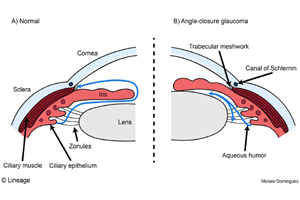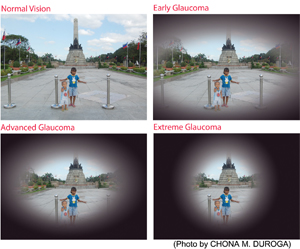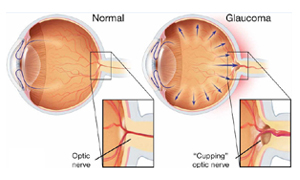Glaucoma
 Glaucoma or 'Kala Motia' is a condition wherein an increased intraocular pressure damages the optic nerve thereby affecting vision. Glaucoma is a disease of the eye that slowly and painlessly takes away your sight. That's the reason it is called 'Silent Thief of Sight'.
Glaucoma or 'Kala Motia' is a condition wherein an increased intraocular pressure damages the optic nerve thereby affecting vision. Glaucoma is a disease of the eye that slowly and painlessly takes away your sight. That's the reason it is called 'Silent Thief of Sight'.
There is no proven way to cure glaucoma or reverse loss of vision which has already been affected. Regular eye examination is the key to help detect this disease in early stages and preserve healthy vision.
At Complete Eye Care, with our best glaucoma specialistsand mostadvanced state-of-the-art equipment we are fully geared not only to detect early stages of Glaucoma but also its treatment and surgical management.
Since most people with glaucoma have no early symptoms or pain, it is important to see your eye doctor regularly so that it can be diagnosed early and glaucoma treatment can be done and an irreversible sight loss can be prevented. If you are over 40 years of age and have a family history of glaucoma, you should have a complete eye exam with an eye doctor at a glaucoma treatment hospital after every one to two years.
A fluid known as aqueous nourishes the front part of the eye. In the normal eye, the rate of production of aqueous matches the rate of its drainage, thereby maintaining optimal pressure inside the eye. With age, disease, trauma or other factors, the channels carrying this fluid may get blocked, increasing the pressure inside the eye. This increased pressure damages the optic nerve, which is the conduit of visual messages to the brain. Working silently, glaucoma damages the outer or peripheral vision first while maintaining the central vision and if not treated on time it may lead to loss of central vision and blindness.
 Glaucoma is also called the silent thief of sight because in the early stages of the disease, there may be no symptoms. By the time glaucoma is detected, the patient has already suffered extensive peripheral vision damage which can no longer be restored. The statistics reveal that by the time people realize that something is amiss and consult a doctor for glaucoma treatment, 90% of them have lost half of their vision. It comes so slowly that it goes unnoticed in most of the people. Worldwide, it is the leading cause of irreversible blindness.
Glaucoma is also called the silent thief of sight because in the early stages of the disease, there may be no symptoms. By the time glaucoma is detected, the patient has already suffered extensive peripheral vision damage which can no longer be restored. The statistics reveal that by the time people realize that something is amiss and consult a doctor for glaucoma treatment, 90% of them have lost half of their vision. It comes so slowly that it goes unnoticed in most of the people. Worldwide, it is the leading cause of irreversible blindness.
Early detection is the key to preserve vision. Once detected, glaucoma can be controlled by medicines (eye drops) or surgery to prevent further vision loss. This can only be done through disciplined and regular glaucoma treatment from an eye specialist. Treatment of Glaucoma is life-long. Glaucoma treatment may include medical management, surgical management or management by lasers.Dr Parul Sony, at Complete Eye Care, specializes in and providing advanced glaucoma treatment in Gurgaon (Gurugram) and Delhi NCR.
Recent Advances in Glaucoma Management
In recent times, there have been a number of advancements in glaucoma management. In the investigational aspect, we now have more sophisticated machines which are able to detect Glaucoma at a very early stage, when no damage to the fibers of the eyes has occurred and this helps in starting the glaucoma treatment on time thereby actually preventing the onset of any possible damage to the eye.
The availability of superior anti glaucoma eye drops has also helped a lot. Newer formulations in medications have also been introduced lately thereby creating wider choice of treatment options for the ophthalmologist.
Management of glaucoma by lasers has also seen ushering in of newer technology where acute angle closure can be promptly dealt with, even when the conventional technique of making a hole by YAG laser does not yield desired results.
The introduction of sophisticated techniques for glaucoma treatment provides tremendous hope for the future of comprehensive medical and surgical management of glaucoma. Dr Parul Sony, at Complete Eye Care, specializes in and providing advanced glaucoma treatment in Gurgaon (Gurugram) and Delhi NCR.
The goal of glaucoma treatment is to lower pressure in the eye thereby reducing the damage to the optic nerve. To treat your condition, doctor may choose to either lower the eye pressure through medicated eye drops, or improve drainage of fluid in the eye or lower the amount of the fluid produced in the eye.
Glaucoma Investigations
Early detection, through regular and complete eye exams, is the key to protecting your vision from damage caused by glaucoma.
 Ophthalmoscopy
Ophthalmoscopy
Ophthalmoscopy is used to examine the inside of the eye, especially the optic nerve. In a darkened room, the doctor will magnify your eye by using an ophthalmoscope (an instrument with a small light on the end). This helps the doctor look at the shape and color of the optic nerve.
Perimetry
Perimetry is a procedure where the patient wears a patch over one eye and looks straight ahead at a bowl-shaped white area. At the same time, the computer presents lights in fixed locations around the bowl. The patient indicates each time he or she sees a light, which is why perimetry is able to provide a map of the visual fields. The type of vision loss associated with glaucoma is relatively specific, and perimetry can detect the typical visual-field defects of glaucoma disorder.The perimetry test is also called a visual field test.
Gonioscopy
Gonioscopy is used to detect which type of glaucoma you have. Once the surface of the eye has been numbed with eye drops, your eye specialist will place a special contact lens on your eye. This special lens will allow your eye specialist to look at the eye’s drainage system and check if the angle where the iris meets the cornea is open or closed.
Newer Diagnostics In Glaucoma
Retinal Nerve Fibre Analysis/OCT
 Retinal Nerve Fibre Analysis/OCT Nerve fibre analysis is a newer method of glaucoma testing in which the thickness of the nerve fibre layer is measured. Thinner areas may indicate damage caused by glaucoma. This test is especially good for patients who may be considered to be a glaucoma suspect and also to indicate if a person’s glaucoma is progressively becoming worse. The OCT instrument utilizes a technique called optical coherence tomography which creates images by use of special beams of light. The OCT machine can create a contour map of the optic nerve, optic cup and measure the retinal nerve fiber thickness. Over time this machine can detect loss of optic nerve fibers. At Complete eye care we have the entire range of glaucoma investigation infrastructure and Dr Parul Sony, at Complete Eye Care, specializes in and providing advanced glaucoma treatment in Gurgaon (Gurugram) and Delhi NCR.
Retinal Nerve Fibre Analysis/OCT Nerve fibre analysis is a newer method of glaucoma testing in which the thickness of the nerve fibre layer is measured. Thinner areas may indicate damage caused by glaucoma. This test is especially good for patients who may be considered to be a glaucoma suspect and also to indicate if a person’s glaucoma is progressively becoming worse. The OCT instrument utilizes a technique called optical coherence tomography which creates images by use of special beams of light. The OCT machine can create a contour map of the optic nerve, optic cup and measure the retinal nerve fiber thickness. Over time this machine can detect loss of optic nerve fibers. At Complete eye care we have the entire range of glaucoma investigation infrastructure and Dr Parul Sony, at Complete Eye Care, specializes in and providing advanced glaucoma treatment in Gurgaon (Gurugram) and Delhi NCR.
Pachymetry
Retinal Nerve Fibre Analysis/OCT Nerve fibre analysis is a newer method of glaucoma testing in which the thickness of the nerve fibre layer is measured. Thinner areas may indicate damage caused by glaucoma. This test is especially good for patients who may be considered to be a glaucoma suspect and also to indicate if a person’s glaucoma is progressively becoming worse. The OCT instrument utilizes a technique called optical coherence tomography which creates images by use of special beams of light. The OCT machine can create a contour map of the optic nerve, optic cup and measure the retinal nerve fiber thickness. Over time this machine can detect loss of optic nerve fibers.
Glaucoma Treatment
Glaucoma is a chronic (long lasting) progressive condition. Any vision loss that has occurred, before glaucoma was diagnosed, cannot be reversed. Glaucoma treatments include medicines, laser trabeculoplasty, conventional surgery, or a combination of any of these. While these treatments may save remaining vision, they do not improve sight already lost from glaucoma.

- Medicines, in the form of eyedrops or pills, are the most common early treatment for glaucoma. Some medicines cause the eye to make less fluid. Others lower pressure by helping fluid drain from the eye.
- Glaucoma medicines may be taken several times a day .Since glaucoma often has no symptoms, people may be tempted to stop taking, or may forget to take, their medicine. You need to use the drops or pills as long as they help control your eye pressure. Regular use is very important.
- Laser trabeculoplasty. Laser trabeculoplasty helps fluid drain out of the eye. Your doctor may suggest this step at any time. In many cases, you need to keep taking glaucoma drugs after this procedure. Laser trabeculoplasty is performed in your doctor’s office or eye clinic. Before the surgery, numbing drops will be applied to your eye. As you sit facing the laser machine, your doctor will hold a special lens to your eye. A high-intensity beam of light is aimed at the lens and reflected onto the meshwork inside your eye. You may see flashes of bright green or red light. The laser makes several evenly spaced burns that stretch the drainage holes in the meshwork. This allows the fluid to drain better.
- Glaucoma Filtering surgery. Conventional surgery makes a new opening for the fluid to leave the eye. Your doctor may suggest this treatment at any time. Conventional surgery often is done after medicines and laser surgery have failed to control pressure. Before the surgery, you will be given medicine to help you relax. Your doctor will make small injections around the eye to numb it. A small piece of tissue is removed to create a new channel for the fluid to drain from the eye.
As with laser surgery, conventional surgery is performed on one eye at a time. Usually the operations are four to six weeks apart. Conventional surgery is about 60 to 80 percent effective at lowering eye pressure.
Laser Iridotomy
Patients with narrow, occludable angles or who have an attack of acute angle closure glaucoma are treated with laser peripheral iridotomy (LPI).
Laser peripheral iridotomy involves creating a tiny opening in the peripheral iris, allowing aqueous fluid to flow from behind the iris directly to the anterior chamber of the eye This typically results in resolution of the forwardly bowed iris and, thereby, an opening up of the angle of the eye. The narrow or closed angle thus becomes an open angle! Prior to the advent of laser, a surgery was necessary to create this bypass (surgical iridectomy).
The laser peripheral iridotomy procedure is completed in the office. Prior to the procedure, the pupil is often constricted with an eye drop medication known as Pilocarpine. Usually, a lens is placed on the eye (after topical anesthetic drops are applied) in order to better control the laser beam. The entire procedure takes only a few minutes. The lens is then removed from the eye, and vision will quickly return to normal. After the procedure, we may recommend anti-inflammatory eye drops for the next few days and a post-operative visit will be scheduled
How should I use my glaucoma eyedrops?
If eyedrops have been prescribed for treating your glaucoma, you need to use them properly and as instructed by your eye care professional. Proper use of your glaucoma medication can improve the medicine’s effectiveness and reduce your risk of side effects. To properly apply your eyedrops, follow these steps:
- First, wash your hands.
- Hold the bottle upside down.
- Tilt your head back.
- Hold the bottle in one hand and place it as close as possible to the eye.
- With the other hand, pull down your lower eyelid. This forms a pocket.
- Place the prescribed number of drops into the lower eyelid pocket. If you are using more than one eyedrop, be sure to wait at least five minutes before applying the second eyedrop.
- Close your eye OR press the lower lid lightly with your finger for at least one minute. Either of these steps keeps the drops in the eye and helps prevent the drops from draining into the tear duct, which can increase your risk of side effects.

Does increased eye pressure mean that I have glaucoma?
Not necessarily. Increased eye pressure means you are at risk for glaucoma, but does not mean you have the disease. A person has glaucoma only if the optic nerve is damaged. If you have increased eye pressure but no damage to the optic nerve, you do not have glaucoma. However, you are at risk. Follow the advice of your eye care professional.
